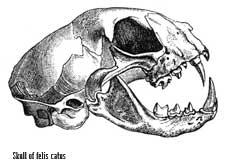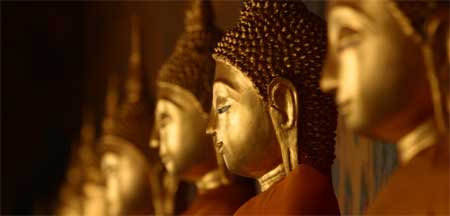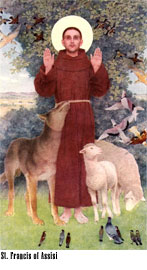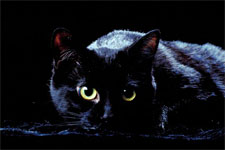|
Mysterious ways: People aren't certain why, but cats have long inspired devotion, even worship, in the humans around them. Perhaps it is their mysterious nature, or the fact that they often disregard their human counterparts and hold them in what seems to be a sort of contempt, but cats have often been at the center of religious cultures. Many cultures have developed some sort of mythology or folklore around cats. Such superstitions are easy to understand. Our forefathers needed some way to make sense of the cat’s mysterious personality, bewildering arrogance, and seductive beauty. These traits have inspired fear in some cultures, and, in others, worship.
 Our records of cats go back centuries. In Cyprus, there exists a 9,500-year-old tomb that contains the remains of a cat resting by the side of what appears to be its human master. This clearly indicates a close and ancient relationship. In Egypt, we have our most detailed records of cats and human society, as well as one of the first societies to treat cats as deities. Our records of cats go back centuries. In Cyprus, there exists a 9,500-year-old tomb that contains the remains of a cat resting by the side of what appears to be its human master. This clearly indicates a close and ancient relationship. In Egypt, we have our most detailed records of cats and human society, as well as one of the first societies to treat cats as deities.
Eye of Ra: The rodent population could easily have gotten out of control along the Nile River but cats protected the Egyptian store houses by killing off rats, mice, and even snakes. They helped control the rodent population so effectively they actually helped Egyptian society flourish. By 1,500 B.C. cats came to be seen as gods. Religious cults rose around them. The goddess Bastert, or “eye of Ra,” became synonymous with the house cat. Portrayed as a woman with the head of a cat, she presided over fertility and motherhood.
New Religion: As domestic cats spread from Egypt to the rest of the world legends and myths went along. Several ancient religions believed cats housed souls, or served as guides from this world to the next. One breed of cat, the Siamese, has long been associated with the Temples of Siam. These cats were believed to house the souls of deceased royalty, even kings. In the Temples, special priests were trained to care for them and the rich provided the cats with the best foods and most comfortable living quarters. In Norse mythology the cat was closely associated with Freyja, the goddess of love, sex, attraction, and even crops. She was often called upon in matters of the heart. She is shown riding a chariot, driven by 2 large gray cats.

Criminal Cats: Perhaps it was this association with sexuality that lead to some serious problems for the cats in many a European country during the Middle Ages. Although cats are not mentioned in the Bible, superstitions sprung up around them. Their nocturnal habits frightened some people and they became associated with Satan. Cats were often accused of killing children by sucking out their breath. They were sometimes tried and convicted before a judge, even sentenced to death. Even owning a cat was dangerous, leading to accusations of witchcraft. The cat population plummeted, nearly collapsing totally. Their exodus from Europe, allowed a massive wave of rodents to enter the continent. As is often the case with rats, they carried disease, which spread over the continent. Plagues hit Europe, killing off large portions of the human population. Fearing disease, the people slowly allowed cats back, which helped curb the plagues. Soon enough the prejudice against subsided and cats reestablished themselves on the continent.
 Patron Saint of Cats: In spite of this tattered history, many a Christian saints had strong affinities with cats. Legend holds that St. Francis was once set upon by a group of rodents but was saved when a cat miraculously sprung from his sleeve and fended them off. St. Jerome, famed for translating the Bible into Latin, owned and loved cats. In fact, he is often depicted with a cat by his side. And even St. Gregory was said to own nothing but one thing – a cat, who often sat with him and prayed. Patron Saint of Cats: In spite of this tattered history, many a Christian saints had strong affinities with cats. Legend holds that St. Francis was once set upon by a group of rodents but was saved when a cat miraculously sprung from his sleeve and fended them off. St. Jerome, famed for translating the Bible into Latin, owned and loved cats. In fact, he is often depicted with a cat by his side. And even St. Gregory was said to own nothing but one thing – a cat, who often sat with him and prayed.
Mohammed, Islam’s major prophet, believed dogs to be unclean but felt cats were sacred. His favorite cat was Muezza. It was said that the prophet often gave sermons while holding the cat in his lap. One story is told of Mohammed being called to prayer, and finding Muezza asleep on the sleeve of his robe. Rather than disturb the cat, Mohammed cut off the sleeve and let the cat sleep. Later, while Mohammed was in prayer the cat came and bowed before him. Cats are still well respected in Islam, and it is considered sinful to mistreat a cat.
 Black Cats: But cats remain mysterious figures in many cultures. People continue to associate their eerie behavior with dark forces. Some call them “the ultimate familiar,” and their very presence suggests the presence of wickedness. Many still believe it bad luck to cross paths with the most feared of all cats – the black cat. A Welsh legend holds that a massive cat haunts the Isle of Anglesey, and once feed itself on 9 scores of soldiers. These legends exist in spite of cats constant rise in popularity. They are the most popular pet in the U.S., and cat fancier associations exist throughout the world. Black Cats: But cats remain mysterious figures in many cultures. People continue to associate their eerie behavior with dark forces. Some call them “the ultimate familiar,” and their very presence suggests the presence of wickedness. Many still believe it bad luck to cross paths with the most feared of all cats – the black cat. A Welsh legend holds that a massive cat haunts the Isle of Anglesey, and once feed itself on 9 scores of soldiers. These legends exist in spite of cats constant rise in popularity. They are the most popular pet in the U.S., and cat fancier associations exist throughout the world.
|
